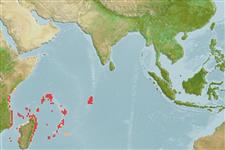Klassifizierung / Names
Namen | Synonyme | Catalog of Fishes(Gattung, Arten) | ITIS | CoL | WoRMS | Cloffa
>
Eupercaria/misc (Various families in series Eupercaria) >
Nemipteridae (Threadfin breams, Whiptail breams)
Etymology: Scolopsis: Greek, skolex = worm + Greek, opsis = appearance (Ref. 45335).
More on author: Cuvier.
Environment: milieu / climate zone / depth range / distribution range
Ökologie
seewasser riff-verbunden; tiefenbereich 5 - 20 m (Ref. 9710). Tropical; 1°S - 23°S, 39°E - 75°E (Ref. 3810)
Western Indian Ocean: including the Seychelles, Chagos Archipelago, Mauritius, Réunion and Madagascar.
Size / Gewicht / Alter
Maturity: Lm ? range ? - ? cm
Max length : 26.0 cm TL Männchen/unbestimmt; (Ref. 9710); common length : 17.0 cm SL Männchen/unbestimmt; (Ref. 3810)
Rückenflossenstacheln (insgesamt): 10; Rückenflossenweichstrahlen (insgesamt): 9; Afterflossenstacheln 3; Afterflossenweichstrahlen: 7. Head scales reaching to between anterior margin of eyes and posterior nostrils. Lower limb of preopercle naked. Antrorse (forward-directed) suborbital spine absent. Pelvic fins long, reaching to or just beyond level of anus. Upper lobe of caudal fin slightly longer than lower lobe in larger specimens. Axillary scale present. Color: Upper body blue or olive green, white below. A yellow stripe from top of snout, through upper part of eye and arching on back to upper part of caudal peduncle. A narrow yellow stripe from top of head running along base of dorsal fin, this stripe disappearing with age. Juveniles blue on upper half of body, white below.
Inhabits sandy bottoms close to coral reefs. Occurs in small groups. Juveniles are solitary (Ref. 9710).
Life cycle and mating behavior
Geschlechtsreife | Fortpflanzung | Ablaichen | Eier | Fecundity | Larven
Russell, B.C., 1990. FAO Species Catalogue. Vol. 12. Nemipterid fishes of the world. (Threadfin breams, whiptail breams, monocle breams, dwarf monocle breams, and coral breams). Family Nemipteridae. An annotated and illustrated catalogue of nemipterid species known to date. FAO Fish. Synop. 125(12):149p. Rome: FAO. (Ref. 3810)
IUCN Rote Liste Status (Ref. 130435)
Bedrohung für Menschen
Harmless
Nutzung durch Menschen
Fischereien: kleinfischerei
Mehr Information
NamenSynonymeMetabolismusRäuberÖkotoxikologieFortpflanzungGeschlechtsreifeAblaichenSpawning aggregationFecundityEierEientwicklung
ReferenzenAquakulturAquakultur ProfilZuchtlinienGenetikElectrophoresesVererbbarkeitKrankheitenVerarbeitungNutrientsMass conversion
Tools
Zusatzinformationen
Download XML
Internet Quellen
Estimates based on models
Preferred temperature (Ref.
123201): 25.7 - 28.2, mean 27.5 °C (based on 219 cells).
Phylogenetic diversity index (Ref.
82804): PD
50 = 0.5000 [Uniqueness, from 0.5 = low to 2.0 = high].
Bayesian length-weight: a=0.01622 (0.00730 - 0.03605), b=2.98 (2.80 - 3.16), in cm total length, based on LWR estimates for this Genus-body shape (Ref.
93245).
Trophic level (Ref.
69278): 3.3 ±0.39 se; based on food items.
Widerstandsfähigkeit (Ref.
120179): hoch, Verdopplung der Population dauert weniger als 15 Monate. (Preliminary K or Fecundity.).
Fishing Vulnerability (Ref.
59153): Low vulnerability (16 of 100).
Nutrients (Ref.
124155): Calcium = 64.5 [40.9, 132.2] mg/100g; Iron = 0.692 [0.339, 1.632] mg/100g; Protein = 19 [17, 21] %; Omega3 = 0.137 [0.082, 0.228] g/100g; Selenium = 25.4 [15.0, 46.2] μg/100g; VitaminA = 75 [20, 222] μg/100g; Zinc = 1.39 [0.97, 2.05] mg/100g (wet weight);
